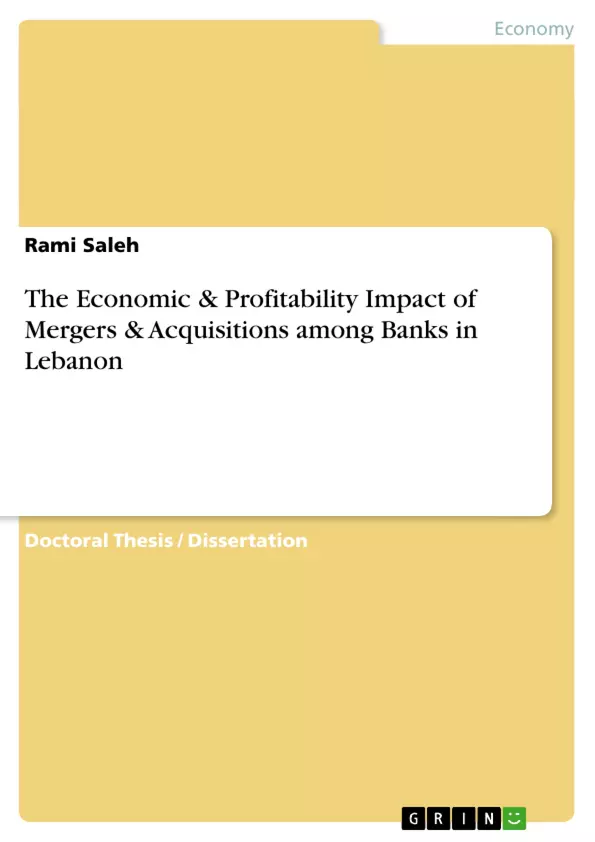A study of the impact of mergers and acquisitions on the economic profitability among Banks in Lebanon
Inhaltsverzeichnis (Table of Contents)
- Chapter 1: Introduction
- 1.1 Overview of Mergers & Acquisitions
- 1.2 Objectives of Mergers & Acquisitions
- 1.3 Bank Mergers & Acquisitions
- 1.4 Overview of the Study Research Design & Empirical Evidence
- Chapter 2: Literature Review
- 2.1 Introduction
- 2.2 The Economic Incentives for Mergers & Acquisitions
- 2.2.1 Value-maximization Motives
- 2.2.1.1 The Operational Efficiency Rationale
- 2.2.1.1.1 Cost Efficiency
- 2.2.1.1.2 Revenue Efficiency & Profit Efficiency
- 2.2.1.1.3 Scale Efficiency/Scale Economies
- 2.2.1.1.4 Scope Efficiency/Scope Economies
- 2.2.1.1.5 X-efficiency
- 2.2.1.2 Diversification
- 2.2.1.3 Replacement of Inefficient Management
- 2.2.1.4 Absorption of Weak & Failing Banks
- 2.2.1.5 Market Power
- 2.2.1.1 The Operational Efficiency Rationale
- 2.2.2 Non-value Maximization Motives
- 2.2.2.1 The Role of Managerial Incentives
- 2.3 Risks of Bank Mergers & Acquisitions
- 2.4 Effects of Banks
- 2.4.1 Applied Methodologies
- 2.4 Review of the Documented Literature & Methodologies on Efficiency
- 2.4.1.1 Operating Performance Studies (Ex-post Studies)
- 2.4.1.1.1 Static & Dynamic Analyses
- 2.4.1.1.2 Advantages & Disadvantages of OP Studies
- 2.4.1.1 Operating Performance Studies (Ex-post Studies)
- 2.5 Justifications of the General Findings
- 2.6 Conclusion
- 2.2.1 Value-maximization Motives
- Chapter 3: Research Design & Methodology
- 3.1 Populations & Sample Selection
- 3.2 Sample Description
- 3.3 Instrumentation
- 3.4 Selected Variables
- 3.5 Data Analysis
- 3.5.1 Descriptive Analysis
- 3.5.2 Inferential Analysis
- Chapter 4: Discussion & Analysis
- 4.1 Discussion
- 4.2 Analysis
- Chapter 5: Conclusion
- 5.1 Overview of the Study
- 5.2 Limitations of the Study
- 5.3 Implications for the Future
- 5.4 Policy Implications
- 5.5 Recommendations for Further Research
Zielsetzung und Themenschwerpunkte (Objectives and Key Themes)
The primary objective of this work is to evaluate the economic and profitability impact of mergers and acquisitions (M&A) on banks in Lebanon. The author seeks to understand the motivations behind such transactions, analyze their impact on efficiency, profitability, and market power, and identify potential risks and challenges associated with bank mergers. Key themes explored throughout the text include:- The economic incentives driving mergers and acquisitions in the banking sector, including value maximization motives such as cost efficiency, revenue efficiency, scale economies, and diversification.
- The role of managerial incentives in M&A decisions and the potential risks associated with mergers, such as integration difficulties, cultural clashes, and loss of talent.
- The impact of mergers on bank efficiency, profitability, and market power, including the implications for competition and customer welfare.
- The methodological approaches used to study the impact of mergers on bank performance, including operating performance studies, static and dynamic analyses, and the challenges associated with measuring efficiency.
- Policy implications and recommendations for future research related to bank mergers and acquisitions in Lebanon.
Zusammenfassung der Kapitel (Chapter Summaries)
- Chapter 1: Introduction - This chapter provides an overview of the banking industry in Lebanon and the increasing prevalence of mergers and acquisitions as a means of consolidation. It discusses the motivations behind M&A activity, emphasizing the desire for growth, market power, and shareholder wealth maximization. The chapter also introduces the research design and methodology of the study.
- Chapter 2: Literature Review - This chapter delves into the theoretical frameworks surrounding M&A activity in the banking sector, exploring a range of economic incentives and motives. It examines the operational efficiency rationale, including cost efficiency, revenue efficiency, and scale economies. The chapter also analyzes non-value maximization motives, such as managerial incentives, and discusses potential risks associated with mergers, such as integration difficulties and loss of talent.
- Chapter 3: Research Design & Methodology - This chapter outlines the research design and methodology employed in the study. It explains the sample selection process, the variables used, and the data analysis techniques applied to investigate the impact of M&A on bank performance.
- Chapter 4: Discussion & Analysis - This chapter presents the results of the study, analyzing the data collected and drawing conclusions regarding the economic and profitability impact of mergers and acquisitions on banks in Lebanon. It explores the relationship between M&A activity and key performance indicators, such as efficiency, profitability, and market share.
- Chapter 5: Conclusion - This chapter summarizes the findings of the study, outlining the key takeaways regarding the impact of bank mergers and acquisitions in Lebanon. It discusses the limitations of the study, implications for the future, and recommendations for further research.
Schlüsselwörter (Keywords)
This work focuses on the economic and profitability impact of mergers and acquisitions (M&A) among banks in Lebanon. Key terms and concepts include: bank mergers and acquisitions, economic incentives, value maximization, operational efficiency, diversification, managerial incentives, risk, efficiency, profitability, market power, operating performance studies, static and dynamic analyses, policy implications, and recommendations for future research.
Excerpt out of 94 pages
- scroll top
- Quote paper
- Rami Saleh (Author), 2009, The Economic & Profitability Impact of Mergers & Acquisitions among Banks in Lebanon, Munich, GRIN Verlag, https://www.grin.com/document/214230
Look inside the ebook



